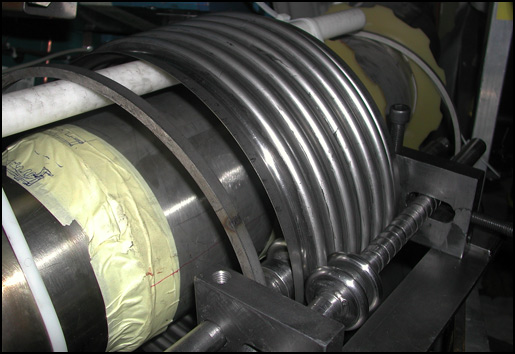
ATLAS e-News
23 February 2011
News from the pit
11 February 2008

Repairing the calorimeter End-Cap C cryoline bellows in situ
The four-year marathon is nearly over – installation work on the ATLAS detector is almost complete. But although we are now in the final straight, the installation teams show no sign of tiring – they are still working hard. It has been another busy week in the pit.
The first of the Small Wheels was moved to Point One on Friday, and last week the ATLAS detector team was preparing for its arrival. “The end-cap magnet is in its “park position”, off the beam axis,” says Michel Raymond. “We pushed it as far as we possibly could into its parking position because the clearance for the descending small wheels is very small – around 30 cm – so we need to create as much space as we can.”
The calorimeter end-cap is also in its open position. “That gives us a clearance between barrel calorimeter and the end-cap calorimeter of 3.1 m – that’s as convenient as possible for people finishing the cabling and preparing the commissioning,” says Michel.
Cables
Although the Small Wheels move is the big news this week, equally important is that each wheel is quickly connected to the detector once it is in position. “We are getting ready to connect all of the cables to the Small Wheels,” says Sergei Malyukov. By the time the Small Wheels arrive at the cavern, all the MDT and CSC cables and most essential TGC cables will be installed in flexible chains, ready to be connect to patch panels, he says.
“The low voltage cables that bring power to all chambers of the Small Wheels are already installed. So once the wheels are in place, all we have to do is to take the cables and plug them into the patch panels on the Small Wheels,” says Sergei.
But that task is more difficult than it sounds. “Each small wheel has around 450 cables,” says Sergei, and so his team needs to plug in around 900 cables in total. “In spite of the fact that most of Small Wheel cables are not very long, they have been squeezed into a very tight space with difficult access. It’s not going to be so easy.”
Sergei thinks his team will have finished patching in the Small Wheels by the end of February, which leaves the cabling team all of March to complete the cabling of ATLAS, and finally clean and tidy up all installed cables to make sure all of those cables are neatly routed.
Cryoline
Meanwhile, elsewhere in the detector, the cryoline team has nearly finished repair work on the outer line that was damaged at the end of last year. “Part of the outer line was completely destroyed, including one of the bellows,” recalls Johan Bremer. There are bellows at intervals along the outer cryoline designed to expand slightly if the metal becomes cold and shrinks, because of insulation vacuum failure.
Fortunately the inner line, which carries the argon to the cryostat, was not damaged and didn’t need to be opened. Replacing the damaged outer line was relatively simple. "You buy the pipe, cut it longitudinally in two and re-weld the two halfs around the inner line," says Johan. But replacing the damaged bellows was more challenging. Bellows are delivered to ATLAS as closed cylinders and can't be simply wrapped around the intact inner line.
“How can you put the new bellows on? Normally you would cut the cryoline open and simply thread on the new bellows,” says Johan. “But if you cut the inner line it would allow water and oxygen to condense inside the cold detector volume– we couldn’t do that.”
“Together with Aboud Falou we got in contact with central workshop and said: ‘What if we just take a plate, roll it to make it a tube around the inner line and make the bellow corrugations in situ ourselves?” The workshop staff (Didier Lombard, Jean-Pierre Brachet and Gilles Favre) suggested using metallic pulley wheels to form the corrugations. The results can be seen in the photograph above. “So you can see in the bottom right corner that there’s one small wheel on inside pushing the metal out, and two small wheels on the outside, pushing the metal in, which forms the corrugations we need to make a bellows,” says Johan.
“When the people from the workshop gave it a try, the first attempt was almost perfect,” he says. “So we thought, if it’s that easy, we can probably make the crenulations deeper, which would give us more flexibility in the bellows. But we found that deeper crenulations weakened the metal, so in the end we went back to the original design.”
Flexibility tests showed that the new bellows expand 6 mm under working conditions, which is similar to the flexibility of the original bellows. The bellows were in place early last week, and the rest of the damaged outer cryoline was replaced late in the week.

Colin Barras
ATLAS eNews